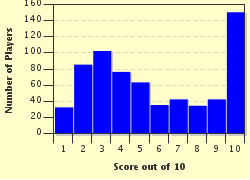Quiz Answer Key and Fun Facts
1. Frisland (not to be confused with Friesland in the Netherlands) shows up on many maps of the North Atlantic Ocean before 1700. It first appeared on a falsified map by the Zeno family in Italy in 1558, and was wrongly included on maps after the fact. "Located" south of Iceland, which group of islands was Frisland most likely confused with?
2. In 1602, Father Antonio de la Ascension was traveling with a Spanish seafarer around North America, and he mentioned a great island off the coast of the continent separated by a great Mediterranean Sea. Despite land explorers' claims to the contrary, what future state was believed to be an island all of its own for over 100 years afterwards?
3. If you looked at Canadian maps from the 1500s, there was definitely one place you never wanted to go. The Isle of Demons was supposedly (and fittingly) populated by demons that attacked any ship nearby. This small "island" was situated off the coast of what much larger, real island?
4. According to Pliny the Elder, Xenophon (ca. 340-354 BCE) mentioned this island as being in Northern Europe. Historians have put it in Helgoland, Lithuania (the coast), Zealand, or Scandinavia, but we may never know. What mythical place is this, perhaps most famous for possibly being the origin for the name of a European sea?
5. Some myths are so ingrained into popular belief that they try to make a mockery of history. The Isles Phelipeaux and Pontchartrain were believed to exist in the middle of Lake Superior. One treaty used Isle Phelipeaux to define the border between the United States and Canada. Which war did this treaty end?
6. In the early 1800s, American Benjamin Morrell decided to explore around Antarctica. He found New South Greenland while trying to navigate the icy waters, but nearly 90 years later his findings were completely disproven when German Wilhelm Filchner found that the sea depth of the area was over 5,000 feet. In what icy sea was New South Greenland supposed to reside?
7. In 1906, Robert Peary witnessed a mirage in northern Nunavut, Canada, and named it Crocker Land. Donald MacMillan was also on that expedition, and in 1913 he decided to actually go out and land on the island. It was obviously not found, and the captain ran the ship aground after getting drunk. Stranded, most of the Crocker Land Expedition was forced to stay in Northern Greenland for how long?
8. When Marco Polo returned from his travels in Asia in 1292, he told a story of the largest island in the world, which he called La grande isle de Java ("The great island of Java"), or simply Jave la Grande. Java Minor has been supposed to be Java, Sumatra, or Simbawa, but Jave la Grande was seen as part of another fictional massive southern continent, known at that time by what name?
9. Europeans during the 16th and 17th centuries simply could not explain why their compasses only pointed north. The assumption was made that a massive magnetic island was situated at the North Pole, drawing needles in that direction. What was the name of this island, which Gerardus Mercator himself estimated to have a circumference of "almost 33 French miles"?
10. Not technically a phantom island, San Serriffe was supposed to be located near Tenerife in the Atlantic Ocean before it was purposely moved near the Seychelles in the Indian Ocean. Its first mention was in 1977 as part of an elaborate April Fools' Day hoax by what British newspaper?
Source: Author
illiniman14
This quiz was reviewed by FunTrivia editor
Pagiedamon before going online.
Any errors found in FunTrivia content are routinely corrected through our feedback system.

